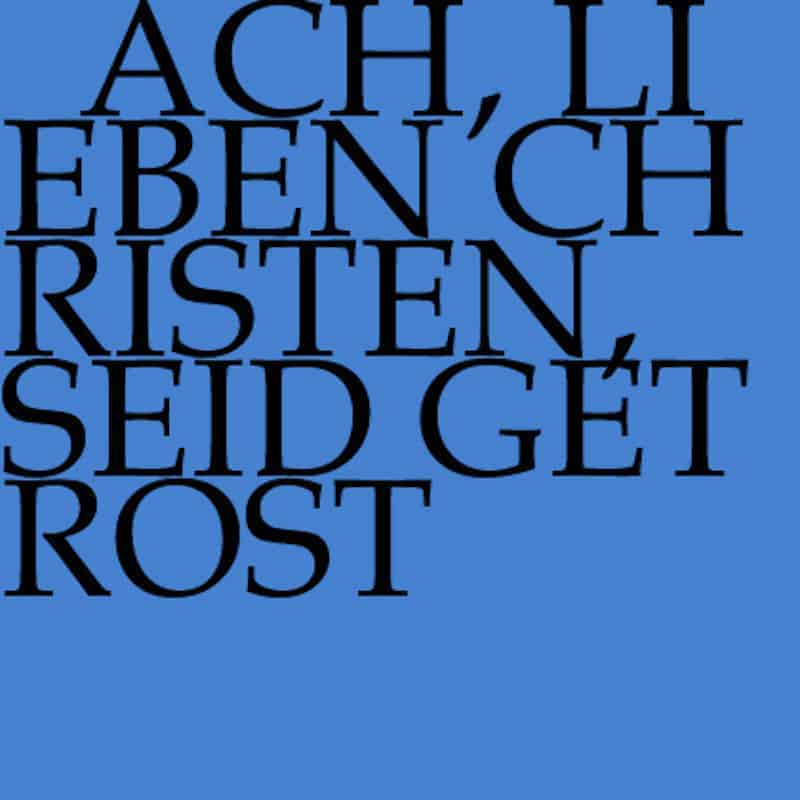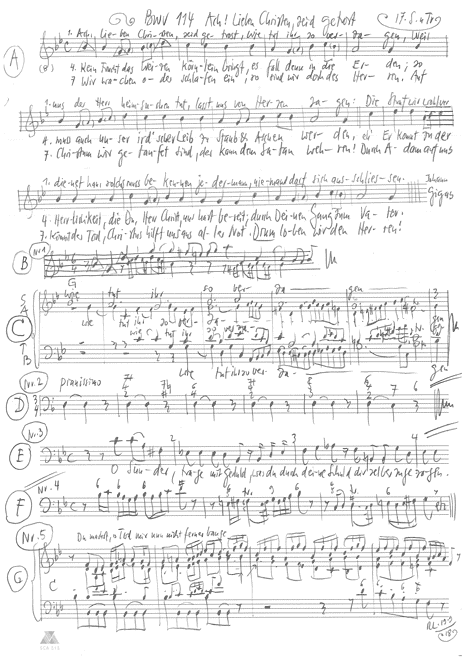Ach, lieben Christen, seid getrost
BWV 114 // For the Seventeenth Sunday after Trinity
(Ah, fellow Christians, be consoled) for alto, tenor and bass, vocal ensemble, oboe I+II, flute, corno, strings and basso continuo

Would you like to enjoy our videos ad-free? Subscribe to YouTube Premium now...
Workshop
Reflective lecture
Choir
Soprano
Linda Loosli, Julia Schiwowa, Simone Schwark, Susanne Seitter, Mirjam Wernli-Berli
Alto
Antonia Frey, Dina König, Simon Savoy, Lea Scherer, Sarah Widmer
Tenor
Marcel Fässler, Manuel Gerber, Tobias Mäthger, Nicolas Savoy
Bass
Fabrice Hayoz, Daniel Pérez, Philippe Rayot, Oliver Rudin, Tobias Wicky
Orchestra
Conductor
Rudolf Lutz
Violin
Renate Steinmann, Monika Baer, Claire Foltzer, Elisabeth Kohler, Olivia Schenkel, Salome Zimmermann
Viola
Susanna Hefti, Matthias Jäggi, Martina Zimmermann
Violoncello
Martin Zeller, Daniel Rosin
Violone
Guisella Massa
Transverse flute
Marc Hantaï
Oboe
Philipp Wagner, Ingo Müller
Corno
Olivier Picon
Bassoon
Susann Landert
Harpsichord
Dirk Börner
Organ
Nicola Cumer
Musical director & conductor
Rudolf Lutz
Workshop
Participants
Niklaus Peter Barth, Rudolf Lutz
Reflective lecture
Speaker
Dagmar Fenner
Recording & editing
Recording date
21.09.2018
Recording location
Speicher AR (Schweiz) // Evangelische Kirche
Sound engineer
Stefan Ritzenthaler, Nikolaus Matthes
Director
Meinrad Keel
Production manager
Johannes Widmer
Production
GALLUS MEDIA AG, Switzerland
Producer
J.S. Bach Foundation of St. Gallen, Switzerland
Librettist
Text
Church hymn by Johann(es) Gigas (1514–1581)
First performance
17th Sunday after Trinity,
1 October 1724
In-depth analysis
Sung to the melody of “Wo Gott der Herr nicht bei uns hält” (Where God the Lord stands with us not), chorale cantata BWV 114 is based on a hymn of penitence from 1561 written by Johannes Gigas. The comparatively high number of surviving copies from the early 19th century, including some from the libraries of Mendelssohn and his contemporaries, are evidence of that era’s focus on the chorale in its revival of Bach’s music.
Based on the notes of the G minor triad, the motifs of the introductory chorus are closely related to the hymn melody. Featuring short dactylic figures that initially appear in the continuo and feverishly repeated motifs in the oboe and string parts, the concerto-like music harbours a mounting end-of-days solemnity that is propelled by the gruffly accented crotchet notes. As in other settings from the chorale cantata cycle, the cantus firmus is presented in long notes in the soprano part; the lower voices, meanwhile, provide an accompaniment of compact chords and imitative phrases. Of particular note are the bold modulations in the transitional sections and in the closing bars of each hymn line.
In the tenor aria, this collective chastisement gives way to a personal reflection that, in line with its elegiac character, is fittingly scored with a transverse flute. Here, Bach takes all the time in the world – for the exact purpose of suspending time: through whispered circling figures and edgy Lombard rhythms, the setting evokes a transient “Jammertal” (vale of sorrow) through which, with only a pianissimo continuo of sparse accompanying notes and staccato quavers to lead the way, there is hardly a path to be found. When, in the vivace middle section, the tenor and flute resolutely surrender to “Jesu Vaterhänden” (Jesus’ hands paternal), for a moment all is buoyant and light-hearted. Yet the large leaps and terse figures on the words “weder aus noch ein” (neither out nor in) recall the helplessness undermining this fragile happiness, a sensation that gains oppressive intensity in the repeat of the A section.
The bass recitative, a veritable sermon in music, presents nothing short of a moral compass for the “lieben Christen” (fellow Christians). Opening with the brotherly warning of “O Sünder, trage mit Geduld” (O sinner, bear with patient heart), expressed in a descending gesture replete with tonal gloom, the setting offers a vivid depiction of human fallibility: from the “Sündenwassersucht” (thirsting after sin) that has humans drinking their own injustice, to the hubris of striving to be God’s equal by eating forbidden fruit, on to the arrogant, self-aggrandisement inherent in “schwülstige Gebärden” (a pompous bearing). Such grave offences must necessarily culminate in an “Erniedrigung” (humbling): in an arioso passage, the bass vocalist must stoop below the continuo part ere a distinctly beautiful cadence returns the humbled soul to the harmonious divine order. Preparation for blessed death is then transformed into the promise that sinful corruption will cede to a new majesty.
Surprisingly, this is followed by a further chorale, but one with a most distinctive aura. Here, Bach allows the soprano to sing the melody completely unadorned to represent the “Unschuld” (innocence) emphasised in the recitative. This simplicity, however, is countered by a ruggedly ascending continuo motive, whose rambling modulations suggest not only the difficult “Gang zum Vater” (path to the father) but also the determined struggle against the temptations of this world and the fear of death and dying. Only now can the alto soloist in the ensuing aria – a cheerful B-flat-major orchestral setting somewhat akin to an oboe concerto – finally surrender to the promise of freedom attained through overcoming this mortal fear. The renewed anticipation of inescapable death thus gives rise to a relaxed confidence culminating in identification with the blessed Simeon, who is presented in the middle section as a model of “verklärte Reinheit” (transfigured purity).
The tenor recitative, by contrast, leads us back to everyday life. With an energetic “Indes” (Till then), the soloist puts an end to all effusion and urges humankind to surrender to the love and care of God (and his son) – not first in death but already in life. This injunction is reinforced by the import of Gigas’s hymn that, in only seven lines, encompasses an entire cosmos of theological signification: from Adam’s original sin to the sacrament of baptism and faith in redemption through the Saviour. When the closing chorale then sings of the praise of God at the very heart of salvation, Bach’s setting imbues this praise with an artistry and beauty of unsurpassed form.
Libretto
1. Chor
Ach, lieben Christen, seid getrost,
wie tut ihr so verzagen!
Weil uns der Herr heimsuchen tut,
laßt uns von Herzen sagen:
Die Straf wir wohl verdienet han,
solchs muß bekennen jedermann,
niemand darf sich ausschließen.
2. Arie – Tenor
Wo wird in diesem Jammertale
vor meinen Geist die Zuflucht sein?
Allein zu Jesu Vaterhänden
will ich mich in der Schwachheit wenden,
sonst weiß ich weder aus noch ein.
3. Rezitativ – Bass
O Sünder, trage mit Geduld,
was du durch deine Schuld
dir selber zugezogen!
Das Unrecht säufst du ja
wie Wasser in dich ein,
und diese Sünden-Wassersucht
ist zum Verderben da
und wird dir tödlich sein.
Der Hochmut aß vordem von der verbotnen Frucht,
Gott gleich zu werden;
wie oft erhebst du dich mit schwülstigen Gebärden,
daß du erniedrigt werden mußt.
Wohlan, bereite deine Brust,
daß sie den Tod und Grab nicht scheut,
so kömmst du durch ein selig Sterben
aus diesem sündlichen Verderben
zur Unschuld und zur Herrlichkeit.
4. Choral – Sopran
Kein Frucht das Weizenkörnlein bringt,
es fall denn in die Erden;
so muß auch unser irdscher Leib
zu Staub und Aschen werden,
eh er kömmt zu der Herrlichkeit,
die du, Herr Christ, uns hast bereit’
durch deinen Gang zum Vater.
5. Arie — Alt
Du machst, o Tod, mir nun nicht ferner bange,
wenn ich durch dich die
Freiheit nur erlange,
es muß ja so einmal gestorben sein.
Mit Simeon will ich in Friede fahren,
mein Heiland will mich in der Gruft bewahren
und ruft mich einst zu sich verklärt und rein.
6. Rezitativ — Tenor
Indes bedenke deine Seele
und stelle sie dem Heiland dar;
gib deinen Leib und deine Glieder
Gott, der sie dir gegeben, wieder.
Er sorgt und wacht,
und so wird seiner Liebe Macht
im Tod und Leben offenbar.
7. Choral
Wir wachen oder schlafen ein,
so sind wir doch des Herren;
auf Christum wir getaufet sein,
der kann dem Satan wehren.
Durch Adam auf uns kömmt der Tod,
Christus hilft uns aus aller Not.
Drum loben wir den Herren.



